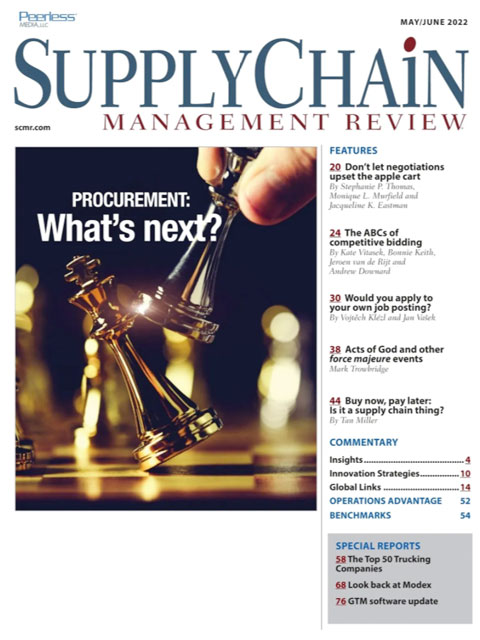Sorry, but your login has failed. Please recheck your login information and resubmit. If your subscription has expired, renew here.
May-June 2022
I recently returned from three days in Atlanta at the Modex trade show. Although advertised as a supply chain event, it’s really a materials handling automation show with a handful of logistics providers thrown in for good measure. Heading out the door to the airport, I had no idea what to expect. The two-year absence from the trade show and conference scene had me, and many of the individuals I spoke to before the show opened, wondering what’s next—not just for the show but for operations in general. If the turnout and the enthusiasm is any indication, I think supply chain is in pretty good shape these days, despite the disruptions we’ve… Browse this issue archive.Need Help? Contact customer service 847-559-7581 More options
Every day, hundreds of organizations conduct competitive bids to pick the best supplier to meet their needs. Unfortunately, too many organizations are using the wrong tools for the wrong job—often resulting in selecting the wrong supplier or developing a contract misaligned with the organization’s objectives. Simply put, using the wrong competitive bidding method is like putting a square peg in a round hole. Forcing it to fit is myopic and inefficient.
To further complicate things, newer more collaborative approaches have emerged that tout the benefit of allowing buyers to gain insight and improved supplier innovation. The question arises: what is the right competitive bidding tool for my situation? Today’s sourcing professionals should understand and enthusiastically embrace the entire suite of tools in their sourcing toolkit and carefully select the method that is most appropriate for their situation.
The changing landscape of strategic sourcing
The COVID-19 pandemic has taught organizations that they must maneuver in a changing environment that is more dynamic than ever. They must embrace and evolve with modern business needs; more and more this means balancing what seems to be insurmountable, conflicting goals of reducing cost structures and increasing flexibility while driving innovation and mitigating risks.
Unfortunately, the tried-and-true tools and tactics adopted as the gold standard over the last 30 years are no longer as effective as they once were. One of the gold standards being challenged is the purpose and nature of conventional competitive bidding tools. For centuries, organizations have thought of procurement as a “make vs. buy” decision. This was especially true as organizations began to explore outsourcing. Many falsely assume that if they buy, they should use competitive market forces to ensure they are getting the best deal. In doing so, the default approach is to use a transaction-based model. This works well for simple transactions with abundant supply and low complexity where the market can correct itself. After all, if a supplier does not perform, just rebid the work.

This complete article is available to subscribers only.
Log in now for full access or start your PLUS+ subscription for instant access.
SC
MR
Sorry, but your login has failed. Please recheck your login information and resubmit. If your subscription has expired, renew here.
May-June 2022
I recently returned from three days in Atlanta at the Modex trade show. Although advertised as a supply chain event, it’s really a materials handling automation show with a handful of logistics providers thrown in… Browse this issue archive. Access your online digital edition. Download a PDF file of the May-June 2022 issue.Every day, hundreds of organizations conduct competitive bids to pick the best supplier to meet their needs. Unfortunately, too many organizations are using the wrong tools for the wrong job—often resulting in selecting the wrong supplier or developing a contract misaligned with the organization’s objectives. Simply put, using the wrong competitive bidding method is like putting a square peg in a round hole. Forcing it to fit is myopic and inefficient.
To further complicate things, newer more collaborative approaches have emerged that tout the benefit of allowing buyers to gain insight and improved supplier innovation. The question arises: what is the right competitive bidding tool for my situation? Today’s sourcing professionals should understand and enthusiastically embrace the entire suite of tools in their sourcing toolkit and carefully select the method that is most appropriate for their situation.
The changing landscape of strategic sourcing
The COVID-19 pandemic has taught organizations that they must maneuver in a changing environment that is more dynamic than ever. They must embrace and evolve with modern business needs; more and more this means balancing what seems to be insurmountable, conflicting goals of reducing cost structures and increasing flexibility while driving innovation and mitigating risks.
Unfortunately, the tried-and-true tools and tactics adopted as the gold standard over the last 30 years are no longer as effective as they once were. One of the gold standards being challenged is the purpose and nature of conventional competitive bidding tools. For centuries, organizations have thought of procurement as a “make vs. buy” decision. This was especially true as organizations began to explore outsourcing. Many falsely assume that if they buy, they should use competitive market forces to ensure they are getting the best deal. In doing so, the default approach is to use a transaction-based model. This works well for simple transactions with abundant supply and low complexity where the market can correct itself. After all, if a supplier does not perform, just rebid the work.
SC
MR


Latest Supply Chain News
- Manufacturing again contracts in October, reports ISM
- 5 common communication issues
- Three frameworks for creative problem-solving in supply chain
- Mitigating geopolitical uncertainty: 4 essential tactics for industrial CSCOs
- Supply chain strategy for medical devices: A Q&A with industry expert Sanjay Gupta
- More News
Latest Podcast

 Explore
Explore
Topics
Procurement & Sourcing News
- 5 common communication issues
- Three frameworks for creative problem-solving in supply chain
- Mitigating geopolitical uncertainty: 4 essential tactics for industrial CSCOs
- Supply chain strategy for medical devices: A Q&A with industry expert Sanjay Gupta
- Inventory Management and the Supply Chain: Outlook 2025
- How technological innovation is paving the way for a carbon-free future in logistics and supply chains
- More Procurement & Sourcing
Latest Procurement & Sourcing Resources

Subscribe

Supply Chain Management Review delivers the best industry content.

Editors’ Picks





